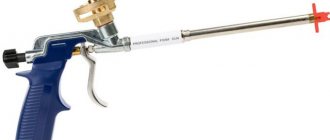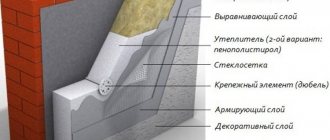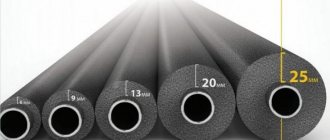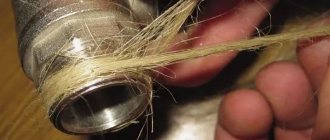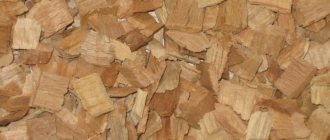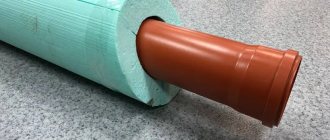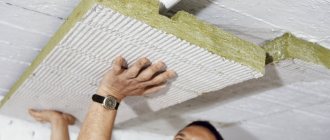One of the most effective insulation materials today is polyurethane foam, or PU foam for short. Manufacturers produce it in the form of plates, foil-coated and sprayed using special mechanisms.
Due to technical difficulties and increased cost relative to other insulation materials, polyurethane foam is not widely used. However, now the Norwegian-made polynor sprayed insulation in foam cylinders has appeared on the building materials market, which has significant advantages.
What is polynore
Polinor is a one-component polyurethane foam, which in its thermal characteristics is superior to polystyrene foam and insulation from various types of mineral raw materials, but the main difference between Polinor and polyurethane foam is its compact packaging in cylinders, which does not require either bulky expensive equipment or the involvement of contractors for operation - you only need a gun - sprayer and strict compliance with the manufacturer's requirements. One Polinor cylinder is enough to insulate 1 m2 of area with a thickness of 5–6 cm.
The weighted average price of insulating 1 m2 of sprayed polyurethane foam with the involvement of a team of insulators will be 17-26 dollars, while the cost of a polynore cylinder is 7 dollars, and all insulation work can be done independently.
A sprayed thermal insulator such as Polinor is designed for thermal insulation of almost all types of surfaces:
- Wall structures made of materials such as brick, concrete, lightweight concrete blocks, wood and wood materials.
- Floors and attic floors arranged on joists.
- Internal surfaces of attic and attic slopes.
- Foundations, basements, ground floors.
- Various communications - water supply, sewer, heating pipes.
Unfortunately, the low pressure in the cylinder will not allow the use of foam to fill cavities in the walls of three-layer structures, but when sprayed onto a surface, one insulator can insulate up to 100 m2 of surfaces with polynore per shift.
Polinor - sprayed insulation, characteristics, application, consumption
CAUTION "POLINOR"!!!
We go to the official website of the so-called “revolutionary insulation POLINOR” and look for contacts. We find no Norway. And there is nothing like this in Norway. Purely a marketing ploy to deceive the consumer. Now let’s look at what the so-called “businessmen” write about the “miracle material”, taking advantage of people’s lack of knowledge, every line on the site is a complete lie, sell at any cost, regardless of the fact that they are simply deceiving people and the people who bought this “pseudo insulation” They will see that they were deceived only after 1-3 years, and maybe much earlier. And then the torment will begin with dismantling and subsequent repairs. By succumbing to the advertising scam, people will suffer losses that are not comparable to the purchase of the “miracle POLYNORA”. And when they contact the seller, they will receive the answer: it’s your fault that you didn’t do everything right. Insulation should be carried out by professionals in order to “not bite your elbow.” Everything is written about materials of this type in the article “ OPEN CELL POLYURETHANE . WHAT IT IS? AND WHERE CAN IT BE USED?
Extract from the site:
“POLYNOR® sprayed polyurethane insulation belongs to a new class of materials for heat and sound insulation”
SUCH A CLASS DOES NOT EXIST IN NATURE OR IN PRODUCTION. This so-called “revolutionary POLINOR insulation” belongs to the class of single-pack polyurethane foam sealants , which we simply call polyurethane foam . It is an order of magnitude more expensive than polyurethane foam from any manufacturer, but the properties are the same, even worse when compared with some manufacturers.
The guarantee is provided for 45 years. And this material has not been tested for durability!!! By their nature, one-component polyurethane systems cannot have such a service life, since they serve for sealing (from air blowing) followed by finishing. Again a marketing ploy to deceive the consumer
The website contains an interesting question: Is this polyurethane foam? The answer to this question: yes - definitely polyurethane foam!!!
Further they write that the properties and characteristics differ from polyurethane foam, in fact this is an empty phrase. Since these are just numbers written out of the blue, absolutely not confirmed by anything. We carried out laboratory tests of this “miracle material” which showed that those selling “Polinor” built their entire business on people’s ignorance and deception.
And now let’s move on to considering the dubious in all respects advantages of the “miracle of nanotechnology Polinor”
Working with POLYNOR® is faster than with any other type of thermal insulation and does not require special skills or additional equipment! - yes, of course, but you need a gun and at least basic knowledge of how to work with polyurethane foam and safety rules.
Questionable advantages of POLYNOR:
-seamless insulation, solves the main problem - eliminating unwanted air convection (drafts, blowing);
-polyurethane foam is the “king” of insulation due to the thermal insulation coefficient of the material; Yes, polyurethane foam, but not Polinor.
- the speed of applying insulation is about 2 minutes for 1 square meter; This, given a certain skill in performing work, even raises doubts
- no additional materials are needed (glue, films, membranes); But as in the case of using polyurethane foam, water is needed to wet the surface. True, the sellers of Polinor do not explain why it is needed, either due to ignorance or because this once again confirms the nature of Polinor as a polyurethane foam.
-economical packaging - you buy as much insulation as you need; Yes , of course, but the price is 2 times more expensive than polyurethane foam.
-does not require installation of a frame (like mineral wool or expanded polystyrene);
-increased adhesion (sticking) to most modern building materials; When wetting surfaces, which is strictly prohibited when applying real polyurethane foam.
-the resulting surface can be painted; Just for what? The surface is clumsy, uneven, and varies in thickness, unless this is an interior design idea for turning a room into a cave or hole.
-high productivity - more than 1 sq. m from the cylinder (with a layer thickness of 6 cm in one pass). Very low productivity at this price for the material
IMPORTANT! It is not a complete waterproofing! And also thermal insulation!!!
AND NOW THE MOST IMPORTANT CHARACTERISTICS OF “MIRACLE MATERIAL POLYNOR” CANNOT BE USED FOR THERMAL INSULATION:
- facades, loggias, verandas, attics, basements, foundations
- apartments, country cottages, residential and non-residential premises
- industrial buildings and structures
- pipelines and other utilities and systems
- isothermal wagons, thermos vans and similar vehicles
According to their characteristics, “MIRACLE MATERIAL POLINOR” and others like it do not comply with existing standards for thermal protection of buildings and structures, and this material also belongs to open-cell materials that do not have vapor barrier properties, much less waterproofing.
Gentlemen, the sellers thought that in Russia we don’t have people who know what polyurethane foam is, so they were deeply mistaken, their “miracle Polinor” cannot by its nature have more than 50% closed cells, in reality the “miracle Polinor” has less than 50% closed cells, that’s all subsequent conclusions.
The gentlemen from Polinor have written another fairy tale about: WATERPROOFING AND FIRE SAFETY
- “86% of Polynor cells are closed and do not allow or absorb moisture, which means that the insulation will not lose its thermal conductivity qualities, and you can be sure of the final result”
- “Flammability class G3 (non-flammable). Within 1 second Polynor goes out without a fire source"
in the Certificate of Conformity issued by ChemStar LLC on November 26, 2014. for No. C.RU.PB04.A.02101 TR1389576 for the Polynor polyurethane system, for a batch of 23733 liters. Sampling report dated October 15, 2014. The certificate is valid from November 26, 2014. The validity period is only for the sale of this batch. And the warranty period indicated on the packaging is 12 months. It's 2021 now. Withdrawal certificate expired.
So this certificate states:
- highly flammable material, group G4
-flammable material, group B3
-material with high smoke-generating ability, group D3
-material highly hazardous in terms of toxicity of combustion products, group T3
The next myth is “lowest thermal conductivity”
By its nature, single-pack polyurethane foam sealant cannot have a thermal conductivity coefficient less than λ = 0.039 W / mK. Below are laboratory tests confirming this.
Test report for water absorption of polyurethane foam system brand POLYNOR (Kazan).
Purpose of the test: testing samples of polyurethane foam system brand POLYNOR (Kazan) for water absorption.
Test period: 04/25/17 – 05/04/17
Test object: polyurethane foam system brand POLYNOR (production date 02/27/2017).
Test content:
- Cutting samples (50x50x50±0.1 mm)
- Conditioning the sample (according to GOST 12423-66) for 4 hours
- Testing (GOST 20869-75)
Measurement and test methods:
- Measuring the geometric parameters of test samples with a Sturm 2030-01-250 caliper (according to GOST 25015)
- Control of linear dimensions with calipers Sturm 2030-01-250
- Measurement and control of sample mass on analytical balances with an error of no more than 0.001 g.
Table 1. Physical parameters of the test sample.
| Sample No. | Brand | Cube with face size, mm | Weight, g | Density, kg/m3 | Surface area, cm2 |
| 1 | POLYNOR (manufactured in Kazan, RT) | 50±0,5 | 2,89 | 23,1 | 150±3 |
| 2 | 2,94 | 23,5 | |||
| 3 | 2,51 | 20,1 |
Note: For POLYNOR polyurethane foam, due to the structure of the plastic itself, the error in measuring the edges was more than 0.1 mm. Before cutting down the samples, the foam was kept at room temperature for at least three days.
Table 2. Thermal conductivity for the tested samples was:
| Brand | Thermal conductivity, W/mK |
| POLYNOR (manufactured in Kazan, RT) | 0,048±0,001 |
Table 3. Water absorption of tested samples.
| Sample No. | Brand | Exposure time, hour | Sample weight before testing | Sample weight after testing | Water absorption,% |
| 1 | POLYNOR (manufactured in Kazan, RT) | 120±2 | 2,89 | 18,21 | 12,3 |
| 2 | 2,94 | 17,32 | 11,5 | ||
| 3 | 2,51 | 16,78 | 11,4 |
After testing for the POLYNOR brand, “sinking” was observed at the fastening points.
Conclusion: as can be seen from the presented results for samples of the POLYNOR polyurethane foam system, water absorption ranged from 11 to 12%.
Thermal conductivity coefficient λ=0.048±0.001 W/mK
And the table presented below once again proves how unscrupulous manufacturers and sellers deceive consumers. Making a profit at any cost.
| Material | Min.cotton wool | Expanded polystyrene | 2-component polyurethane foam | Penoizol | POLYNOR |
| Parameter | |||||
| Thermal conductivity, W/(m*deg.) | 0,045 | 0,033 | 0,028 | 0,06 | 0,023 |
| Water absorption | 0,02 | 0,02 | 0,01-0,03 | 0,140 | 0,01-0,03 |
| Frame | needed | needed | — | needed | — |
| Additional tool | needed | needed | needed | needed | — |
| Adjustable layer thickness | — | — | Yes | Yes | Yes |
| Insulation of complex and hard-to-reach surfaces | —- | — | possible | — | possible |
| Cost per 100 m2 with work, rub. | 50 000 | 50 000 | 75 000 | 45 000 | 40 000 |
| Installation speed 100 m2, min. | 240 400-600 | 240 400-600 | 240 240 | 280 280 | 200 200 |
The information provided in this article is for the benefit of the consumer only and does not serve any purpose as advertising.
People should know that they are trying to sell and sell a product of very dubious quality, presenting it as polyurethane foam.
The scope of application of this “nanotechnology” product “ MIRACLE MATERIAL POLINOR ” packaging.
"MIRACLE MATERIAL POLYNOR" has followers of "TEPLIS"
The hybrid “MIRACLE MATERIAL POLYNOR” cannot be called real polyurethane foam!!!
Golubev V.A. Construction engineer
Plekhanov S.A. Construction engineer
Kucherenkov M.Yu. Expert in the production of sprayed polyurethane foam.
CAUTION POLYNOR continued
OPEN LETTER
NATIONAL UNION OF CONTRACTORS MANUFACTURERS OF SPRAYED POLYURETHANE FOAM AND POLYUREA.
General Director of ChemStar LLC Musatov E.R.
Before publishing the article “CAUTION POLYNOR”, we repeatedly tried to contact you by phone, explaining to your employees the reason for the need to talk with you, they explained to us that you were not there, and when you would deign to talk to us, they did not know.
YOU ignored our attempts to contact you. And we wanted to ask you questions about your “miracle” material:
-how and according to which State Standards, on what equipment you determined the number of closed pores
-which State Standard did you use to determine moisture absorption?
-why if you position your material as thermal insulation, there is no data on sorption moisture absorption
-why are there no durability tests, your statements about durability of 50 years are not confirmed by anything and contradict the research of Soviet, Russian, and foreign scientists, because they studied real polyurethane foams, and not on-packaging polyurethane foam sealants. After all, the product belongs to the class of open-porous materials.
-why in your answers to the question: What coating layer do I need? The thickness data on your website does not correspond to the calculations according to SP 50.13330.2012 Thermal protection of buildings. SP 131.13330.2012 Building climatology. SP 23-101-2004 Design of thermal protection of buildings
-why is the vapor permeability coefficient taken for rigid polyurethane foam, although your product “POLINOR” is not one of them?
- according to which State Standard the thermal conductivity coefficient was determined, your data in the technical characteristics (one gets the impression) are simply copied from the data on rigid polyurethane foams produced with freons. Your product “POLINOR” is not one of these.
For reference: even polyurethane foams produced using water as a blowing agent have a density of at least 55 kg.m3, different ratios of components and a thermal conductivity coefficient of not less than 0.042 W/(m*K). Because carbon dioxide is very quickly replaced by air within hours.
The certificate dispelled another myth of the POLINOR product about its high thermal insulation characteristics.
-Where is the test report for vapor permeability?
-where is the test report for sound absorption and according to which GOST the tests were carried out
-why, according to the law, work on the production of polyurethane foam is considered harmful and difficult, but for you everything is very simple, just gloves, a mask (what kind, a carnival one?). If a professional operator studies for at least 244 hours and receives only a 3rd category, performs work only under the supervision of a 5th category operator, then you have to apply it yourself without knowing anything other than your dubious instructions.
-Where are the tests on the use of your product “POLINOR” in the areas where you recommend its use?
-where are tests by climatic zones
- what fire extinguishing additives did you use so that the product “POLINOR” from flammability group G4 became G3
Are there too few questions about your “miracle” material, and these are only part of the questions based on the description of the “POLINOR” product and its technical characteristics.
In order to present your claims to us about the article, study the works of the founder of polyurethane foam production Otto Bayer, scientists B.A. DOMBROW, J.H. SAUNDERS, K.K.FRISH, Klempner D., T. Thomson, Soviet and Russian scientists A.A. Berlin, F.A. Shutov, Denisov, A.B., L.D. Evseev, Vorobiev V.A., Andrianov R.A., Lebedev V.S., Tarakanov O.G., I.G. Romanenkov, Murashov Yu.S., Kiselev I.Ya. fundamental research by Dementyev A.G., which is used by scientists not only in Russia, but also in the world. This is just a small list of authors whose research we relied on when writing the article. In the Article “CAUTION POLYNOR” everything is laid out on the shelves, as it really is, without fiction, but using only facts. Never and nowhere has one-pack polyurethane foam sealant been compared to thermal insulation materials. People who position POLINOR as a thermal insulation material simply do not know anything about polyurethane foam, real polyurethane foam, as a thermal insulation material. Read the article on the portal “APPLICATION OF SPRAYED POLYURETHANE FOAM IN CONSTRUCTION.”
The domain ppup.rf was provided free of charge by a member of the NSPPN ppu and pm IP Pauker E.V. to create an information portal for NSPPN pp and pm.
To IP Pauker E.V. a letter was received from ChemStar LLC, which cannot be regarded as anything other than a threat. Compiled by Razumov Pavel Vladimirovich signed by Musatov E.R., sealed
ChemStar LLC.
The letter states:
We believe that all information published on the website www.ppu.rf is deliberately false and posted with the aim of misleading users in order to benefit from the sale of products not manufactured at.
Again another lie.
The portal is not involved in advertising or selling goods; it was created in the interests of consumers, customers and contractors.
The article “CAUTION POLYNOR” was written based on the knowledge of polyurethane foam members of the NSPPN pp and pm, and the literature studied by the above listed authors. Polinor products have been produced since 2014, and the work experience of the founders of NSPPN ppu and pm in the industry of polyurethane foam production by spraying is from 9 to 20 years. The question is who has more knowledge in the use of polyurethane foam, without knowledge of what rigid polyurethane foam is, it is not possible to carry out high-quality work on the production of polyurethane foam at various facilities. We have works completed by our members 20 years ago and they stand and work, which POLINOR can boast of, except for incomplete laboratory tests.
All technical characteristics of “POLINORA” do not correspond to reality, as they contradict the nature of polyurethane foam.
Another excerpt from the letter:
WE DEMAND:
Immediately delete the entire on the page www.ppup.rf/p/p11/ under the heading “CAUTION POLYNOR”!!!, and also write a refutation stating that the information provided is unreliable and indicated by mistake.
In case of failure to comply with the requirements specified in the complaint, HIMSTAR LLC will be forced to go to court, as well as to law enforcement agencies with a request to publish a refutation, block the site, and also to collect compensation from you in the amount of 1,000,000 rubles for posting information discrediting business reputation HIMSTAR LLC.
General Director signature E.R. Musatov
And here HIMSTAR LLC demands that we abandon all knowledge about polyurethane foam, i.e. all the research about polyurethane foam, its properties, application, production of polyurethane foam accumulated over decades is not true, but the miracle “POLYNOR” is nanotechnology (one-pack polyurethane foam sealant) a revolution in production and application.
Consumers who have suffered from the use of the miracle material “POLINOR” due to inaccurate information from the manufacturer, on the basis of the consumer protection law, can go to court for damages.
We provide assistance to consumers in clarifying the technical characteristics of the “miracle” product “POLINOR”
Followers of the product “POLINOR” have appeared, to which the information provided about “POLINOR” fully applies.
This:
— Tytan Professional THERMOSPRAY professional sprayed polyurethane thermal insulation, and studying the Product Catalog “Professional Products for Construction 2018” Selena in Russia: Selena Vostok LLC, this product is not available, but on the website https://tytan-professional.ru/ru/produkty/ thermospray-naplyamaya-tploizolyatsiya-profssionalynaya/ - description of this “miracle” material.
- SPRAYED INSULATION PENOPLEX® FASTFIX® - manufacturer PENOPLEX
https://www.penoplex.ru/katalog/dlya-doma-i-kvartiry/napylyaemyy-uteplitel-penoplex-fastfix/
We provide information assistance to consumers in explaining the technical characteristics of the “miracle” product “POLINOR” and similar products.
President of NSPPN PPU and PM Golubev V.A.
Chairman of the Polyurethane Foam Committee of NSPPN PPU and PM Kucherenkov M.Yu.
Chairman of the Polyurea Committee of the NSPPN PPU and PM Plekhanov S.A.
Chairman of the Committee for Relations with Contractors NSPPN PPU and PM Shtyvalo V.V.
Member of the NSPPN pp and pm Pauker E.V.
The advantage of polynor foam
The strengths of the polynore include the following qualities:
- Cost comparable to other popular insulation materials.
- Easy installation.
- Fast curing.
- No cold bridges.
- Safety for humans.
- Durability – 40-50 years.
- Excellent adhesion to basic building materials.
- Resistance to most solvents and liquid materials used in construction - acetone, alcohol, toluene, gasoline, kerosene, oils, cement and cleaning solutions.
- Efficiency.
Polinor insulation has the following technical indicators:
- Thermal conductivity 0.023…0.025 W/μ.
- Volumetric weight ≥28 kg/m3.
- Water absorption 2%.
- Permissible heating -121 °C.
- Sanitary safety - certified for residential use.
Customer Reviews
Even despite the fact that some are very wary of this product, overall reviews about it remain positive:
“I replaced almost 90 sq.m. in just a few hours. ceilings As a result, my layer thickness was not entirely uniform and varied from 5 to 9 mm. I attribute this to the fact that it was my first time working with such a tool and I couldn’t get used to it. Fortunately, Polinor can be applied again, so the surface can be easily leveled. Since there are children at home, I was worried that the smell would last too long. But no, the next day everything disappeared!” Alexander, 32 years old.
“So, what do we have? There is a small standard balcony measuring 3.5 square meters. m., which I managed to insulate with Polinor in less than an hour. Moreover, the costs turned out to be much less than if I had used mineral wool. The downside is that the balcony is not always as warm as we would like, and applying the product requires a temperature of +20-25 degrees. In addition, it is desirable that the weather be calm, otherwise the foam will be worse and more will be wasted. It turns out that this remedy can only be used in summer or late warm spring. Otherwise, either wait for warm weather, or go back to the same mineral wool.” Igor, 28 years old.
“We decided to start insulating the house and for this purpose order a special team that has equipment for spraying. However, when we calculated the costs, we decided that we couldn’t afford this method and it would be much cheaper to do everything ourselves. By the way, the basement was insulated, as well as the existing ceiling between it and the house. Friends recommended expanded clay, but there is too much fuss with it - you still need to bring it, drag it into the room, and then cover it with all sorts of vapor and waterproofing. In short, we decided to save money, effort and time with the help of Polinor. In the end, we didn't make a mistake! Parents really don’t trust any innovations, but they were also impressed with the result. As a result, this year their cold balcony will be insulated with Polinor.” Maxim, 38 years old
Disadvantages of polynore
Unfortunately, the ideal insulation has not yet been manufactured, and polynore, despite all its positive qualities, has disadvantages:
- Destruction under the influence of sunlight (UV spectrum).
- Not durable when exposed to water.
- Does not withstand contact with hydrochloric and sulfuric acids, methylene chloride, chloroform, dichloroethane.
- Temperature limitation during installation is +18…+35°C; at lower temperatures, foam consumption increases significantly.
- Toxicity upon application.
- The manufacturer's limitation on the thickness of the insulation layer is 6 cm.
- There is no vapor permeability; as a result, the insulation does not allow the wall to breathe, which requires forced ventilation in the insulated room.
- To apply thermal insulation, you need to purchase a construction gun with a nozzle.
- Flammability – polynor refers to self-extinguishing materials with flammability group G3.
- Contact with the ground is undesirable; when insulating the foundation externally, waterproofing is required.
Scope of application
I’ll probably call this insulation “folk”. Why? Because working with it does not require special knowledge, and therefore, no search for third-party performers. If we are talking about small “private” volumes of insulation, then you can handle it yourself.
Polinor is used for insulation:
- External and internal walls of residential and non-residential premises built from almost any building material;
- Floors with a so-called non-load-bearing structure and cavities between the joists;
Gun with nozzle - pitched roof;
- Basement, basement, foundation;
- Garage and other non-insulated doors (from the inside);
- Heating pipes, water supply, sewerage and other communications;
- Containers, baths, cisterns;
- Loggias, balconies, attics, verandas and attics;
- Transport kungs, wagons, insulated vans, painting booths, etc.
Just in case, let me clarify - it (Polinor) has an orange-pink color.
Polynore installation
Since the sprayed heat insulator Polynor is toxic during operation, installation of insulation is carried out in personal protective equipment: goggles, suit, respirator, gloves. Before installation, it is important to remove dust from the surface to be treated.
Then the surface is degreased with any organic solvent. Since polynor insulation has excellent adhesion, the evenness of the insulated surface only affects foam consumption. It is also necessary to protect non-insulated surfaces from foam splashes.
The installation of battens and frames for thermal insulation is not required, however, if a curtain wall is planned, the frame for it must be installed before insulation is carried out.
The heat insulator is installed as follows:
- Screw the nozzle supplied with the cylinder onto the barrel of the gun until it clicks, then remove the cap from the cylinder and polynore, and screw the gun rod into the cylinder itself;
- shake the container for 2…3 minutes;
- a stream of foam is directed to the required area.
Without minimal experience, it may be difficult at first to achieve uniform layer thickness, which is adjusted by tilting the gun nozzle. It is recommended to shake the container periodically. After completing the work, the tools must be washed with a special cleaner, since frozen foam is almost impossible to clean.
Polymerization occurs within 40 minutes, final hardening occurs after 3 days. The use of special films and membranes for vapor barrier is not necessary, which also reduces the cost of thermal insulation.
How to insulate with Polinor: the whole process and nuances
In fact, there is nothing complicated in this procedure. We prepare the surface and apply insulation evenly, in a small layer. The instructions are on the bottle.
Can be applied even in sub-zero temperatures! I applied Polinor at -5 degrees, although the instructions say that the minimum is +5 degrees. The most important thing is to warm the container to room temperature. You can keep it in hot water in a bucket and take turns taking the cylinders as you use them, you can put them on batteries at home and also use them in turn
- You need to prepare the surface. Clear of debris and dirt, dust and snow.
- We insert the can into the gun and apply it evenly over the surface in a small layer.
- When changing cylinders, we use a cleaner - we clean the nozzle and the place where the cylinder is screwed.
That's basically it, there's nothing complicated about it. We use it like regular polyurethane foam. But there are still a few nuances:
- Be sure to buy a new gun for Polinor, there will be fewer problems.
- The attachments that come with the cylinders may not fit the gun. I just heated it with a lighter and inserted it.
It is better to buy a new gun for working with insulation
The nozzle that comes with the balloon
What can I say - Polinor is fast, convenient and effective. If you have questions, ask in the comments.
The result of the work done. It took about 4-5 hours to do everything

